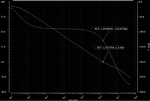Fabien
Full Member level 1

Dear all!
I'm trying to amplify a differential signal what may vary from a few hundreds of micro-volts to tens of milli-volts. The main challenge is to design this amp in sub 1V and in sub 1µA.
I designed OpAmp but won't work with such a low input voltage.
The only way I found is to amplify separately these two differential signals (ie. with a cascode amp) and then amplify it with OpAmp (but it requires two casc amp and 1 opamp).
An other amplifier I tried is a double diff amp (one differential pair whose outputs is connected to an other differential pair). It almost work but there is a long delay (once the differential signal is below zero, the output of this double diff amp wait half a micro-sec to decrease).
Question : What kind of amplifier (it also could be a comparator) could I design for such a low input voltage? (I tried with INA but... gave-up).
I'm trying to amplify a differential signal what may vary from a few hundreds of micro-volts to tens of milli-volts. The main challenge is to design this amp in sub 1V and in sub 1µA.
I designed OpAmp but won't work with such a low input voltage.
The only way I found is to amplify separately these two differential signals (ie. with a cascode amp) and then amplify it with OpAmp (but it requires two casc amp and 1 opamp).
An other amplifier I tried is a double diff amp (one differential pair whose outputs is connected to an other differential pair). It almost work but there is a long delay (once the differential signal is below zero, the output of this double diff amp wait half a micro-sec to decrease).
Question : What kind of amplifier (it also could be a comparator) could I design for such a low input voltage? (I tried with INA but... gave-up).








